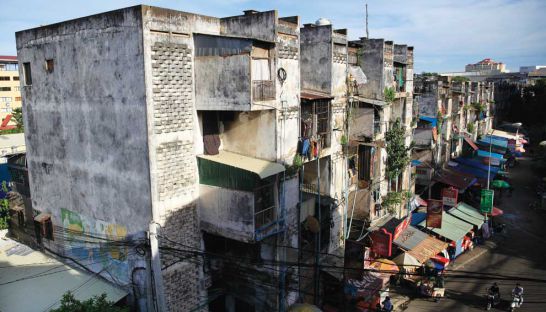Government’s plan to develop public housing takes on shape
Government’s plan to develop public housing takes on shape
Phnom Penh’s public housing policy, aimed to provide affordable housing for the middle income class and low income class, is expected to boost the construction sector in Cambodia as an increased population and rapid urbanisation is expected to create a demand of more than a million new homes by 2030, according to a draft national policy announced this past year.

Through the policy, the government will work with private developers, investors and banks in providing affordable housing for low to middle income families, said Seng Lot, spokesperson for the Ministry of Land Management, Urban Planning and Construction, adding that officials are being trained from a national to sub-national level on the policy, as well as working with international partners to increase support and regulation over the implementation of the policy.
“It is possible that the houses would be built on public land by private developers then the houses would be sold at a compromising price to buyers,” he said.
In order to assess the needs of the people, which would then determine the timeframe and location of the housing construction, The Department of Housing was created under the Ministry of Land Management, Urban Planning and Construction to collect data and oversee housing projects following the announcement of the policy, Seng said.
Depending on the needs of the people and the location, different collaborations between the government and the private sector could be made, Seng explained.
“The policy will not create competition for private developers,” he added. “They are welcome to work with the government on this project, and if they want to do their project, they can still continue to do so.”
Kuy Vat, president and CEO of VTrust Group, told Post Property yesterday that the policy could improve trading activities within the sector by allowing more people to acquire home ownership.
“The policy will help boost more sales if cheaper houses are being built and the bank could provide lower interest rates,” he said. Mortgage lending that banks offered previously loaned with interest rates of 10 to 11 per cent, whereas over the last few years, they have dropped to 7 to 8 per cent.
Government supplied housing would not dampen or hinder private sector housing developments, said Chhay Sina, sales and marketing manager of Borey Vimean Phnom Penh.
“I believe that the public housing project, as it is built for lower income families, will only provide very basic housing facilities while private developers’ projects usually come with good basic infrastructure and facilities like electricity, clean water, schools and economic opportunities,” she said. “The houses built through the policy are targeted for middle income or poorer families, so it would not be in a standard that would attract higher income families like the project we are doing now,” said Chhay Sina, sales and marketing manager of Borey Vimean Phnom Penh.
However, others expressed concerns over possible issues in adopting this policy. Srey Chanthy, an independent economic analyst, said in an email that although the policy would benefit low-income families, including government servants who are in need of subsidized housing as basic human rights, the possibility of corruption could arise if “undisciplined officers [are] involved.” This, he said, would ruin the potential of these housing developments.
However, Srey said that through a transparent manner and a Public-Private Partnership model, the policy could have a beneficial impact on the construction sector without challenging the private sector, which caters to other demographics.
“It will create more jobs in building maintenance and associated services,” he said. “It will surely contribute to economic growth.”













